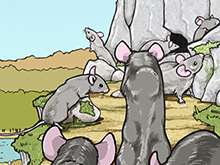Wired for change: Gene expression study reveals first steps of evolution in gene regulation

A study of gene expression led by scientists at the EMBL-European Bioinformatics Institute (EMBL-EBI) and the University of Cambridge has revealed the first steps of evolution in gene regulation in mice. Published in the journal Cell, the research has implications for the study of differences in gene regulation between people.
"We found an impressive amount of variation between these apparently very similar mice in terms of transcription-factor binding, which is an important indicator of gene-regulation activity," says Paul Flicek of EMBL-EBI. "Often you'll see a specific combination of these transcription factors acting in concert – and it was fascinating for us to see just how important these combinations are. They're much more likely to be conserved over the course of evolution than whatever DNA sequence they might be binding to."
The team studied gene expression in five very closely related mouse species in order to pinpoint changes at the very earliest stages of evolution. To do this, they compared the way that three transcription factors (TFs) bind to genes to control if they're turned on or off in liver cells in the different mouse species.
"By looking at mice that are very closely related to each other, we were able to capture a snapshot of what regulatory evolution is happening," explains Duncan Odom of the University of Cambridge. "That's important because it's much harder to see how something has evolved when you don't have a clear picture of the starting point."
Say you wanted to know how an orange tree evolved, but you could only compare it to an elm or oak. You'd have greater insight into how an orange tree evolved if you could compare it to much more closely related plants like grapefruit and lemons, which could give insight into how each came from an ancestral citrus plant. In this study, instead of comparing leaf and fruit shapes, the team looked at gene regulation in mice that had only recently diverged from one another. They demonstrated that TFs work in clusters that are conserved in order to ensure genetic and evolutionary stability.
The researchers contrasted their findings with gene-regulation data from another model organism, Drosophila, to see where the similarities lay. They found that there were a lot more differences between closely related mouse strains than there are between distantly related fruit-fly strains.
"Mammals have lots of DNA kicking around that doesn't code for proteins, while fruit flies have relatively little. So a mouse's regulatory wiring will just have a lot more wiggle room than a fruit fly's," says Paul. "That gives us a clearer picture of what we can expect to learn about mammalian genetic regulation from fruit flies."
The study could help scientists understand how gene regulation differs from one person to the next, explaining why genes that cause disease in some people don't have that effect in others.
More information: Stefflova, K., et al. (2013) Cooperativity and rapid evolution of co-bound transcription factors in closely related mammals. Cell, published online 1 August 2013. DOI: 10.1016/j.cell.2013.07.007
Journal information: Cell
Provided by European Molecular Biology Laboratory

















